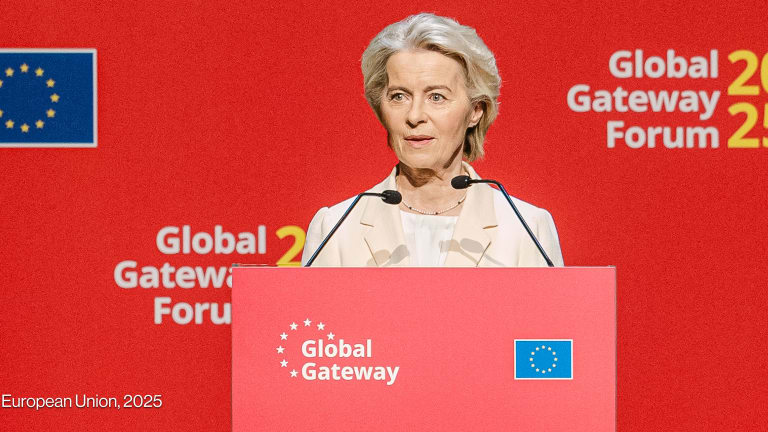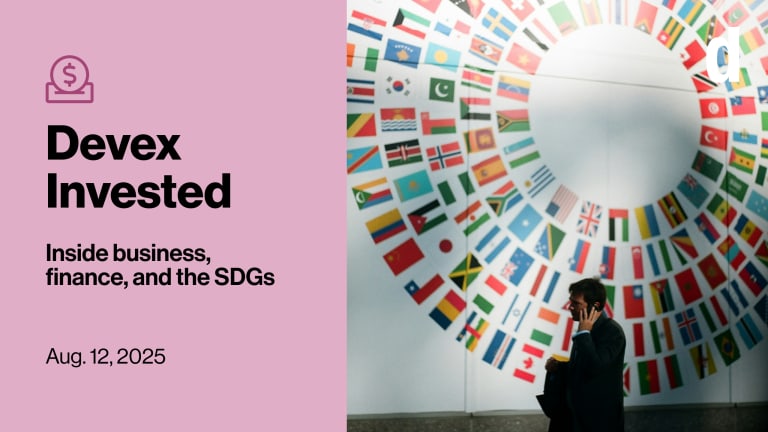Want to engage with the European Fund for Sustainable Development? Here's how
The new EFSD, part of the EU's External Investment Plan, is worth up to 4.1 billion euros, with the goal of spurring investment in Africa and the countries around Europe's borders. How can organizations get involved?
BRUSSELS — European officials showcased their External Investment Plan at the AU-EU Summit in Côte d’Ivoire this week, eager to convey the potential of an initiative they hope will leverage 44 billion euros ($52 billion) in investment in Africa and the countries around Europe’s borders. Meanwhile, development banks, private investors, small- and medium-sized businesses, and other actors are grappling with how to engage with the EIP, and the accompanying European Fund for Sustainable Development, or EFSD. The European Commission last week released its most extensive guide yet to the investment plan. But how can development actors get involved? The investment plan, which is designed for development projects in Africa and the EU neighborhood, consists of three pillars: the EFSD, technical assistance, and improving the investment climate. Technical assistance under Pillar 2 is designed to support development projects by providing experts who can help with training, advice, and knowledge sharing. Pillar 3 aims to use policy dialogue to improve a country’s climate for investors, for instance, by making representations to local governments to remove red tape. This will also include dialogue between private sector players from Europe and Africa, under the Sustainable Business for Africa (SB4A) platform. The EFSD, under Pillar 1, has two components. The first is 2.6 billion euros ($3 billion) for the Neighbourhood Investment Facility and Africa Investment Facility, two pre-existing programs that use blended finance — that is, the use of public money to make development projects more appealing to investors, such as through technical assistance or interest rate subsidies. The second part is the EFSD Guarantee, backed by up to 1.5 billion euros. This allows the European Commission to assume some of the investment risk in developing and least-developed countries should a project fail. It could cover situations such as a coup d’etat; a borrower failing to pay; or floods and other weather events caused by climate change. Roberto Ridolfi, a director at the Commission’s development arm, DEVCO, told a European Parliament committee last week that in some cases the guarantee may also cover potential losses due to currency fluctuations. “If you invest in euro and you cash in local currency, the devaluation and inflation risk is very strong, and therefore all investors are looking for a guarantee hedging somehow against that devaluation risk. It’s not easy — it’s very expensive, and it’s very complex. That’s why we are looking at a proposal that will eventually cover the different windows,” he said. Funding under all aspects of the EFSD will be channeled, for now, through around a dozen financial institutions that the EU trusts to handle its money, such as the European Bank for Reconstruction and Development and the European Investment Bank, as well as EU countries’ bilateral development banks (a full list can be found here). The commission is also open to working directly with commercial banks in future, provided they pass an assessment. All three pillars under the EIP will be overseen by a commission-run secretariat, making this the first port of call for those with project ideas or looking for investment opportunities. Businesses in developing countries are being encouraged to contact their local EU delegation, where staff are being instructed in how to work under the EIP’s three pillars. The secretariat’s website is not yet live, but interested parties can visit the EIP homepage, and email the secretariat at: ec-eip-efsd-secretariat@ec.europa.eu. For the past year, trusted financial institutions have been looking at the potential for projects that follow the EFSD’s criteria: projects require a development focus, for instance, and would not happen without EU support. Earlier this month, the commission announced the first five investment windows — thematic areas designed to steer investments toward development objectives. These are: sustainable energy and connectivity; financing for micro, small, and medium-sized enterprises (MSMEs); sustainable agriculture, rural entrepreneurs and agribusiness; sustainable cities; and digital for development. In December, the commission expects to issue a call for proposals under at least some of these headings to financial institutions, with a likely submission deadline of late January, Ridolfi said. The financial institutions will then submit proposed investment programs, or PIPs. These are indicative of the areas they would like to work in, but won’t contain every project, leaving the institution open to accept more projects once their priorities are set. “Sustainable energy and connectivity, and SME financing, are the two windows most ready,” Ridolfi said. “From what we hear from the financial institutions, we will already have a few proposals on these two areas, because they’ve been working on this.” The financial institutions may submit numerous PIPs under different windows, and may be chosen to administer multiple programs. The EIB and commission will then examine these proposals and put them to the EFSD operational board for approval. Ridolfi said that in order not to immediately use up the entire guarantee — which is supposed to cover investments through to 2020 — the EFSD should aim to spread the risk, with some projects in safer areas to offset riskier investments in least-developed countries. As part of the PIP assessment, the EFSD’s experts will recommend how much each financial institution should pay to take advantage of the EFSD Guarantee. This is done to avoid distorting local markets, where other banks may already be offering guarantees to investors. To incentivize investments in least-developed countries, the EU will charge less for these guarantees than for those in lower and middle-income countries. Ridolfi said the idea was to “compensate with a premium on the guarantees that we are charging in Kenya for losses that we are likely to make in South Sudan,” for example. Ridolfi added that the commission expects the first guarantee contracts to be signed in April or May 2018. For now, ahead of the call for proposals, the financial institutions are trying to ascertain which projects are realistic. “In Africa, it’s not the ideas that are lacking,” said an EU official, who was authorized to speak to the media on background. “It’s not the pipeline of ideas that’s the problem — it’s about how feasible they are.” That is where the commission hopes technical assistance under the EIP’s second pillar will help. The commission has also been approaching banks and institutional investors, so far around Europe, to canvass their interest in investing in projects under the fund. “In addition to African and European capital investments, some of the private capital can also come from other countries. We want to mobilize private capital,” the EU official said. “The lesson we learned over the past 10 years of implementing blended finance was that the guarantee modality is quite effective at mobilizing private capital into developing countries.” Ridolfi characterized the different levels of investor via the metaphor of a house. “[First] you have to create the basement, with the money from the guarantee, which is the very risky money,” he told European lawmakers. “On top of this basement, then you create the ground floor with development bankers, which is two or three times [the amount of] the basement. And then on top of the ground floor you have 10 times [the commission’s contribution] from pension funds, with a different degree of risk-taking. Very low risk, the big money from pension funds; intermediate risk, the development bankers; and high risk, from us.” That is how, he suggested, “our 100 million [euros] can become 2 billion [euros] of investment.” Read more Devex coverage on EU aid.
BRUSSELS — European officials showcased their External Investment Plan at the AU-EU Summit in Côte d’Ivoire this week, eager to convey the potential of an initiative they hope will leverage 44 billion euros ($52 billion) in investment in Africa and the countries around Europe’s borders.
Meanwhile, development banks, private investors, small- and medium-sized businesses, and other actors are grappling with how to engage with the EIP, and the accompanying European Fund for Sustainable Development, or EFSD.
The European Commission last week released its most extensive guide yet to the investment plan. But how can development actors get involved?
This story is forDevex Promembers
Unlock this story now with a 15-day free trial of Devex Pro.
With a Devex Pro subscription you'll get access to deeper analysis and exclusive insights from our reporters and analysts.
Start my free trialRequest a group subscription Printing articles to share with others is a breach of our terms and conditions and copyright policy. Please use the sharing options on the left side of the article. Devex Pro members may share up to 10 articles per month using the Pro share tool ( ).
Vince Chadwick is a contributing reporter at Devex. A law graduate from Melbourne, Australia, he was social affairs reporter for The Age newspaper, before covering breaking news, the arts, and public policy across Europe, including as a reporter and editor at POLITICO Europe. He was long-listed for International Journalist of the Year at the 2023 One World Media Awards.








